Guatemalan Chocolate, a Sweet Love Affair
For chocolate lovers, Guatemala is a sweet place to be on Valentine’s Day. This is especially true if you visit La Antigua Guatemala, where chocoholics can indulge in so many delightful ways.
Luscious chocolate bars, exquisite truffles and liquor-filled bonbons are but a few of the beautiful chocolate concoctions that are available at the many artisanal sweet shops scattered throughout town.
And as if this weren’t enough to tempt a sweet tooth, Antigua boasts its own chocolate museum. In addition to producing edible cacao products, the ChocoMuseo educates the public about the entire chocolate-making process through interactive workshops, beautifully crafted exhibits and entertaining tours.
Whether you visit the ChocoMuseo at its 4a calle oriente or 5a avenida norte location, it’s almost impossible not to be struck by the enormous sense of pride Guatemalans take in their country’s rich chocolate heritage and its acclaim as the birthplace of cacao.
“All of our chocolate products are hand-crafted right here on the premises,” said Carol Pérez, general manager of the ChocoMuseo. Pérez explained that the museum buys most of its high-quality cacao from Alta Verapaz in the north and from Guatemala’s Pacific coast. The cacao is then refined with state-of-the-art equipment at the museum’s location near the arch on 5a avenida.
Rudy Limán, one of the museum’s cacao chefs, demonstrated how these machines help to refine the texture of the chocolate.
“The refining process, which takes many hours, is critical,” he stressed, “otherwise you will end up with chocolate that’s either too coarse or too pasty.”
The word cacao originates from the Maya word ka’kau’. The Maya revered the cacao tree because they believed that ka’kau’ was discovered by gods in a mountain. Carl Linnaeus, a Swedish botanist renowned for classifying plant life, renamed cacao, Theobroma, which translated from Latin means “food of the gods.”
In ancient times, the Maya, shamans and Aztec kings all consumed cacao in beverage form and believed it to be an elixir with aphrodisiacal qualities. Cacao is also mentioned in ancient texts for its ceremonial and medicinal uses.
Even though cocoa originated in Central America thousands of years ago, its production and popularity have gone global. Some of the largest producers of cocoa in the world are now found in Africa, Asia and South America—more specifically in Ghana and the Ivory Coast, Indonesia, Peru, Ecuador and Colombia.
The main growing region for the Maya in Guatemala was originally located in what is now the department of Suchitepéquez. Today, one of Guatemala’s principle cacao-growing areas is situated even farther north in Alta Verapaz.
Decades ago, Guatemala was designated as one of the world’s top producers of cacao. Sadly, this is no longer the case, as cacao wasn’t considered a cash crop like coffee and sugar cane, which slowly took over as more marketable exports.
On a beautiful morning in late December, I set out in a pickup truck from Cobán in the department of Alta Verapaz with Jorge Caceros, manager of quality control for FEDECOVERA, a federation of cooperatives that provides technical assistance and marketing services to cacao-growing communities in and around the municipalities of Baja and Alta Verapaz.
We were headed to one of many local parcelas or smaller cacao farms in the vicinity. The majority of the population in this region is indigenous and the Mayan language spoken is Kekchi. Alta Verapaz is also renowned for its “chipi chipi,” a term used to describe the phenomena of fine drizzle that falls throughout the day in the tropics of Guatemala and Mexico.
“Cacao trees require hot, rainy and tropical environments, within 15 degrees latitude north or south of the equator,” stated Caceros. “Cacao also grows best when there are other crops with lush vegetation to provide shade for its trees.”
As we strolled through the parcela, I was struck by the abundance of flourishing and fragrant cardamom and allspice plants that provided the cocoa trees and their precious pods with protective cover.
Caceros noted that although the weather was unusually warm for this time of year and climate change appears to be affecting crops with a likely reduction in product for the first time in 2016, cacao has seen a resurgence in this area in the last couple of years.
Because FEDECOVERA supports and empowers small farmers, encouraging them to cultivate one of the finest cacao products in the region, so many more of the local producers have additional income now to invest in more land and trees. These smaller investors are being mentored to produce for a larger market.
Three types of cacao trees grow in Guatemala: criollo, forestera and trinitario. Classified as “fine grade,” criollo is the oldest known and rarest variety because it produces the least amount of seeds.
According to Gg, owner and creator of Cacao Junajpu, one of several artisanal chocolate makers in and around Antigua, criollo cacao is the direct descendent of the first cocoa trees domesticated by the Maya over 3,000 years ago.
The chocolate derived from this variety is of the highest quality, classified as one of the finest flavored chocolates with no trace of bitterness. She went on to explain that many cacao farmers grow trees that produce lower quality chocolate because they are more resilient to disease and therefore more likely to guarantee a good harvest.
Fine cocoa accounts for less than 5 percent of world cocoa production because these trees are susceptible to disease and produce lower yields than other strains of the cocoa tree.
Gg, who came to Guatemala to study with the Maya people, has been producing her exquisite artisanal drinking chocolate for nine years now. “I really wanted to learn how to make ancient Mayan cacao the way it used to be,” she stated. “All of the knowledge is passed down orally, so I moved around and talked to Mayan priests and locals in many Guatemalan communities before starting to experiment with different ingredients.”
What sets fine chocolate apart from much of that produced for the mass market is the fermentation process. Unless the beans are first fermented, the full flavor of the chocolate is simply not there. To make chocolate properly, cacao beans and their pulp are fermented before being dried and roasted.
From there, the husks are removed and the nibs are ground and refined. About half of the cacao produced in Guatemala is fermented. All eating chocolate is made with fermented cacao, however the majority of cacao consumed in Guatemala is drunk, not eaten.
Although the quantity of cacao produced here has decreased compared to other countries, Guatemala’s chocolate is some of the best in the world and is earning a well-deserved reputation for its high grade and quality.
There are many talented artisanal chocolate makers in Guatemala. If you have the time to explore, the names and websites of some of them with product description, location and history are listed here.
Artisanal Chocolate Makers in Guatemala
Cacao Junajpu junajpu.com
Chocolá chocola.com
Danta Chocolate dantachocolate.com
Diego’s Artisan Chocolate diegoschocolate.com
Fernandos Kaffee fernandoskaffee.com
Ixcacao ixcacao.com/Chocolate
For more information about the ChocoMuseo, its workshops, world-wide locations and a list of all of its edible as well as cacao-inspired beauty products, go to ChocoMuseo.com
To learn about FEDECOVERA’s products, history and inspiring contributions to women’s empowerment, health, education, reforestation and organic production, go to Fedecovera.com
REVUE article by Kerstin Sabene – photos by Kerstin Sabene and Gg
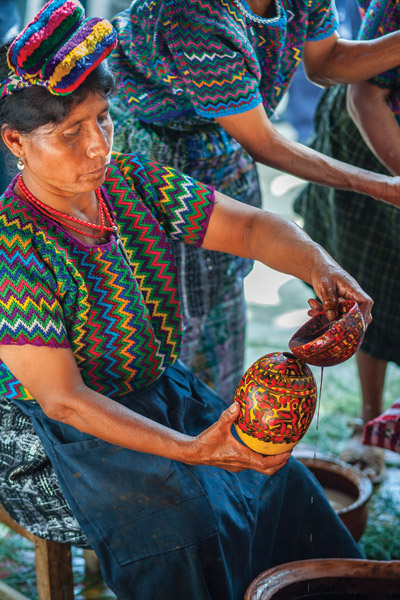
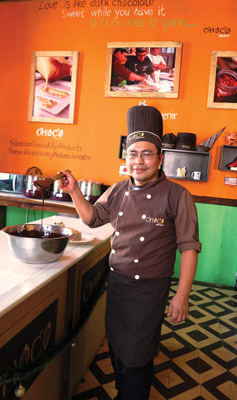
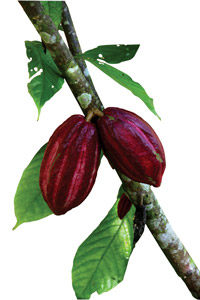
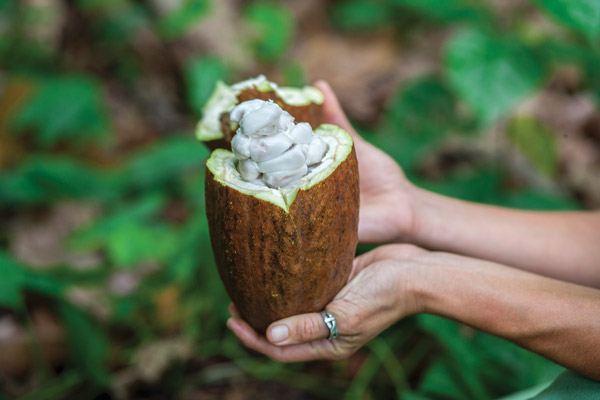
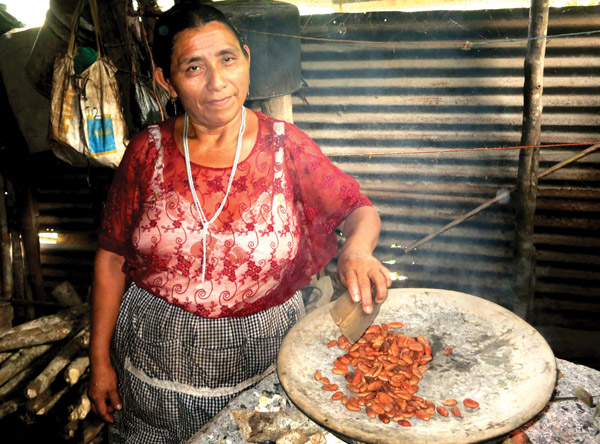
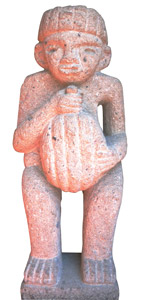
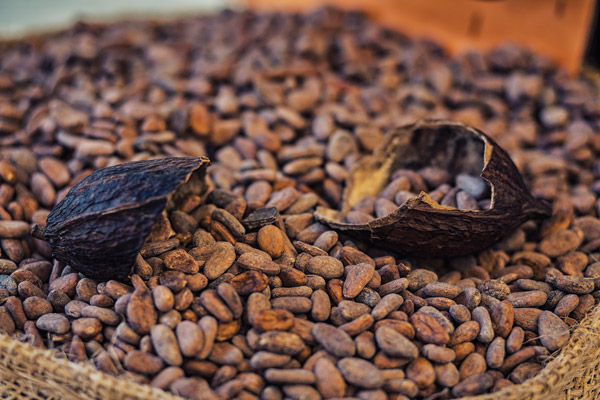
I would like to refresh Antigua’s cultural memory of local chocolate bars and drinking chocolate by posting a review by Shel Horowitz from 2006,a year after we at Tostaduria Antigua invented as far,as I can ascertain, the first whole bean cacao honey bar in the world and the first truly ‘bean to bar’ then and probably even today because everyone else here uses cocoa powder and cocoa butter to make their chocolate sugar sweetened bars.In fact I believe ALL chocolate bars using sugar require more cocoa butter in their bars than is found naturally in cacao beans but honey in part mimics cocoa butter and melts with the cocoa butter around body temperature so the are a perfect combination for making a truly ‘whole bean’ bar without need for any part of the ‘Dutch process’- devised in Holland in 1827 and which is the standard even today to make cocoa butter and cocoa powder.Chocolate-sugar bars require around 65% cocoa butter whereas natural beans contain only 52% to 58% so the Dutch process of a ton to 3 tons of pressure to separate the butter from what becomes chocolate powder is basically mandatory.
Mr.Ghirardelli of SF started a rumor or,I believe,a joke in 1865 in California that he was making his cocoa butter from a ‘broma’ process.I only heard of it when Mitchell Bodian’s ChocoMuseo arrived and claimed to make his own cocoa butter from the ‘broma process’.Later they admitted that they DID NOT but bought their cocoa butter made by the conventional Dutch press process.
I should take a moment to refresh Gg’s cultrural memory as well.She states she began making her drinking chocolate,(made just like the nice folks in San Juan Del Obispo,Mixco and Oaxaca),about 9 years ago.This would be almost as early as we began making cacao honey bars in 2005.In fact she began after seeing us making cacao honey bars and simple ground bean unsweetened cacao for baking,etc.She was making regular visits to a man living near us studying ‘Mayan astrology’ and found us around 2008.I know this because it coincided with the time someone tried to filch our idea of using Theobroma Bicolor or ‘pataxte’,
which we discovered by accident in cacao beans we bought, and had it identified as such in 2005 as well.I could not easily find an adequate amount of pataxte to buy and grind at the time,(only a few surviving older women in Suchitepequez use it to make a corn drink called ’tiste’ and it is mentioned in Popul Vuh) so I told just about any traveler and coffee client who came in the store about it in hopes they might find some for me in their travels in Guatemala cacao area and bring some back for me to grind.Someone decided to take advantage of my openness and get a head start in making the real white chocolate that I assumed could be made from the butter in its whole beans.Fortunately although they procured a small amount of pataxte they didn’t know enough to simply grind the beans to test it for its butter properties.We did and published about that on the internet in 2009.
Below is a link to the old frugalfun.com blogspot of Shel Horowitz that mentions us in 2006 and below that a link to an indymedia UK site where I first posted my research and development of pataxte for a solid whole bean white chocolate product in 2009.
Sincerely
Tony Ryals
Tostaduria Antigua
2da Avenida Sur #34
http://www.frugalfun.com/antigua-guatemala.html
Antigua has at least two excellent chocolatiers: Chocotenango, with its high-end truffles in exotic flavors (including rosemary, thyme, cardamom), local owner, and very reasonable prices (most small truffles were 4 quetzales—about fifty cents). I had a cardamom and a seven-spice, and enjoyed both. Dina had an Elvis, which she described as like a Reese’s, and a white chocolate mocha truffle.
But the chocolate shop I preferred was Tostaduria Antigua, Sixth Street West at Seventh Avenue South, an amazing little coffee bean shop that also sold very dark, rough artisenal chocolates as well as whole cacao beans. Owned and operated by an intense Norteamericano from Texas, this shop offered something very close to a pure chocolate experience. It’s not for everyone, but I was utterly thrilled
https://www.indymedia.org.uk/en/2009/04/428980.html
Pataxte,(Theobroma Bicolor): Real White Chocolate Of The …
https://www.indymedia.org.uk/…/428980.html
Independent Media Center
Paradoxically many cacao growers do not even have pataxte growing on their land and providing shade and soil … Tony Ryals | 30.04.2009 01:50 | Ecology.
Very informative chocolate commentary Tony- You always were a pioneer in Antigua!
Chocolate is wonderful-and each one as unique as it’s makers. Each one with it’s distinctive twist.
it’s wonderful that you have inspired people to honor and respect Cacao. I’ll have to go try Gigi’s now that you write about it too! Thanks and keep on making that chocolate!